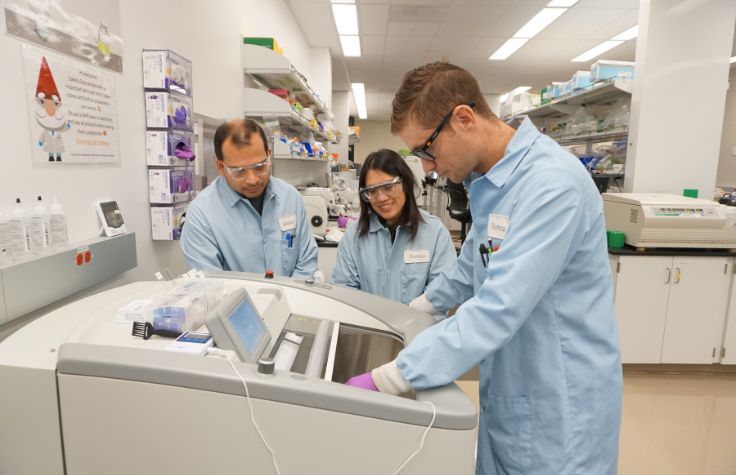
4 February 2025
Ovarian is the deadliest of all women’s cancers; more than half of cases are identified after the disease has already spread. Today, global ovarian cancer survival rates remain low while incidence rates continue to rise. The World Ovarian Cancer Coalition projects that by 2050, the annual incidence of the disease will increase by 55% to nearly 500,000 cases. In the next quarter century, almost 12 million people will be diagnosed with ovarian cancer and eight million will lose their lives.
“I still find it quite shocking that ovarian cancer outcomes are so poor and lag behind so many other cancers,” says Clara MacKay, CEO of the World Ovarian Cancer Coalition. “The five-year survival rate is still only in the 35% to 45% range in higher-income countries, and much, much lower as you move into lower-resource countries. If you compare ovarian to a disease like breast cancer, where survival rates are more than 90%, you get a real sense of the extent to which a great gap has been in progress.”
Registered in Canada, the coalition works with a global network of 200 patient advocacy organizations. Its diverse members are focused on ovarian cancers as well as gynecologic and other women’s cancers or, more broadly, women’s health, but all are committed to improving survival and quality of life for anyone at risk of the disease or living with it.
Currently, no screening tool exists for ovarian cancer and early symptoms are frequently misdiagnosed as other health conditions, like irritable bowel syndrome or urinary tract infections. “Women will often go through several different diagnoses over many months before they land on their ovarian cancer diagnosis,” MacKay says. “That is all very precious time that’s been lost in relation to the opportunity to treat.”

The coalition works to raise awareness about the disease and support the efforts of its member organizations, many of which operate with limited resources. Through surveys and studies, the coalition generates evidence to fill gaps in the understanding of how ovarian cancer impacts women, their loved ones, and the health care systems serving them. Coalition leadership believes the most powerful advocacy is led by evidence. “The only way you can change policy and drive progress is to back up your calls to action with strong evidence,” MacKay says.
Genetic testing to prevent hereditary ovarian cancer
Ten to twenty percent of all ovarian cancers are attributed to an inherited mutation in a cancer predisposition gene, like BRCA1 or BRCA2. The World Ovarian Cancer Coalition released a white paper in December 2024 with the aim of exploring the current landscape in hereditary ovarian cancer, the potential of genetic testing, and how to address challenges in implementing this technology across both high- and low-resource settings.
One of the white paper’s key recommendations is a call for strategies to support the implementation of population-wide genetic testing, which could prevent millions of cancer cases worldwide. The paper cited a 2020 study in the journal Cancers (coauthored by one of the contributors to the coalition white paper, Professor Ranjit Manchanda) that explored the potential impact of population-wide BRCA screening. In just the United States, for example, Manchanda estimated that population-based testing would prevent 312,906 cases of breast and ovarian cancer and 41,789 deaths over the course of an average lifespan, compared to existing practice.
“Through their thought leadership and advocacy, the World Ovarian Cancer Coalition clearly demonstrates the urgent need to reduce barriers to equitable access to genetic testing,” says Illumina Global Patient Advocacy Lead Shirlene Badger, PhD. “Illumina is proud to partner with the coalition in this vital work, because genetic testing gives people the knowledge they need to take control and be proactive about prevention. Additionally, genetic testing enhances care and outcomes for those affected by this deadly cancer.”
Other recommendations from the white paper include looking at copayment arrangements, instituting comprehensive tumor and germline testing, building infrastructure in clinics, and even creating digital pathways for patients that can reduce or eliminate barriers to accessing genetic testing altogether.
A clearer picture of the patient experience
Previous research from the World Ovarian Cancer Coalition, including its 2018 Every Woman Study and its upcoming supplement Every Woman Study: LMIC Edition (for “lower- and middle-income countries”), compiles robust patient experience data from more than 4000 women in over 60 countries. The data provides critical information that’s necessary to drive progress in health care. “What we’ve found is that no one country has all the answers, and often, countries will perform better in some areas and poorer in others,” MacKay says. For example, the 2018 study found that the average time between initial onset of symptoms to diagnosis is much longer in the US than in the UK, but once a person gets a diagnosis, the time to treatment is much shorter. The coalition believes that by studying these differences, regions can learn from one another and adopt practices that produce better outcomes.
Gathering data for the Every Woman Study: LMIC Edition was not easy, which highlights the many challenges clinicians and patients face daily in these settings, including civil unrest, natural disasters, and COVID-19. One of the lead clinicians involved in the study went into hiding for months because of the high risk of kidnapping in their region. However, MacKay says the study also reveals the innovation and creativity being used to deliver health care in these settings. As an example, she points to hospitals that set up their foyers to host patients who travel long distances and do not have the resources for overnight accommodations. She says she is humbled by the level of commitment shown by patients, advocates, and clinicians to continue this important work.
Some of the issues the coalition has identified could be addressed with practical solutions. Others are more challenging and deeply entrenched socially, like the stigma around women’s reproductive health. MacKay says that finding women who can be champions in their communities is essential for educating people and destigmatizing the disease.
Sharing stories and elevating the cause
World Cancer Day is February 4, 2025. It’s a chance for the global community to come together to share lessons learned, discuss challenges, and celebrate progress. This year’s theme, “United by Unique,” is a call to action to continually put patients at the center of cancer care—something that the World Ovarian Cancer Coalition strives to do each and every day through their work. The coalition will observe the day by sharing personal stories from ovarian cancer survivors around the globe.
“World Cancer Day is an opportunity to share the message that everyone’s experience with ovarian cancer is unique, but collectively we have the power to make a huge difference to the outcome for all,” MacKay says, adding that everything—from where someone lives to how their health care system works and the resources they have available—impacts the way they experience cancer. “No country has all the answers. Our strong belief is that by creating the evidence we need to learn from one another, we can all do better for everyone impacted by this cancer.” ◆
Look for the World Ovarian Cancer Coalition’s Socioeconomic Burden of Ovarian Cancer Study, forthcoming in JCO Global Oncology. Undertaken in partnership with the World Health Organization, the study quantifies the societal impact of ovarian cancer on caregivers, health care systems, and national economies.


